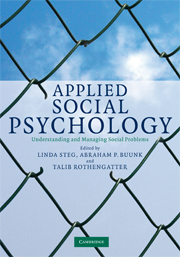Book contents
- Frontmatter
- Contents
- List of figures
- List of tables
- List of boxes
- List of contributors
- Acknowledgments
- 1 Introduction to applied social psychology
- 2 The USE of theory in applied social psychology
- 3 Applications of social psychology to increase the impact of behaviour-focused intervention
- 4 Research designs in applied social psychology
- 5 Social psychology and economic behaviour: heuristics and biases in decision making and judgement
- 6 Social psychology and immigration: relations between immigrants and host societies
- 7 Applying social psychology to the classroom
- 8 Social psychology and environmental problems
- 9 Gender issues in work and organizations
- 10 Social psychology of health and illness
- 11 Social psychology and mental health
- 12 Social psychology and modern organizations: balancing between innovativeness and comfort
- 13 Social psychology and the study of politics
- Index
- References
5 - Social psychology and economic behaviour: heuristics and biases in decision making and judgement
- Frontmatter
- Contents
- List of figures
- List of tables
- List of boxes
- List of contributors
- Acknowledgments
- 1 Introduction to applied social psychology
- 2 The USE of theory in applied social psychology
- 3 Applications of social psychology to increase the impact of behaviour-focused intervention
- 4 Research designs in applied social psychology
- 5 Social psychology and economic behaviour: heuristics and biases in decision making and judgement
- 6 Social psychology and immigration: relations between immigrants and host societies
- 7 Applying social psychology to the classroom
- 8 Social psychology and environmental problems
- 9 Gender issues in work and organizations
- 10 Social psychology of health and illness
- 11 Social psychology and mental health
- 12 Social psychology and modern organizations: balancing between innovativeness and comfort
- 13 Social psychology and the study of politics
- Index
- References
Summary
Introduction
Economic theory of utility maximization
The British philosopher Jeremy Bentham postulates in his book The principles of morals and legislation (1789/2000) that the pursuit of pleasure and the avoidance of pain explain all human behaviour. Later this principle was called ‘hedonic utility’. Utility was then considered to be a cardinal measure of pleasure. Cardinal means that utility should be measured in absolute numbers. Disutility referred to negative emotions that people avoid, such as pain. People select the maximum utility: the net balance of the pursuit of pleasure and the avoidance of pain. People act rationally if they maximize their utility. The notions of maximizing utility, and thus acting rationally, were extremely relevant for nineteenth-century economists. Economists (Jevons, 1871/1970) saw the principle of hedonic calculus, the computation of utility as the net balance of pleasure and pain, as a universal law of human behaviour from which economic relations and market exchange behaviours could be derived.
Economists did not get the support of psychologists of that time for their principle of hedonic calculus. William James (1890) criticized this approach, arguing that the determinants of behaviour cannot be reduced to a simple hedonic calculus.
This instigated the idea of freeing economic theory from psychological influences, either by accepting hedonic calculus as a simple starting point for economic theorizing or by excluding psychology completely by measuring utility from expenditure or preference. It also implied that economists gradually shifted from measuring cardinal (metric) to ordinal (non-metric) utility.
- Type
- Chapter
- Information
- Applied Social PsychologyUnderstanding and Managing Social Problems, pp. 117 - 140Publisher: Cambridge University PressPrint publication year: 2008



